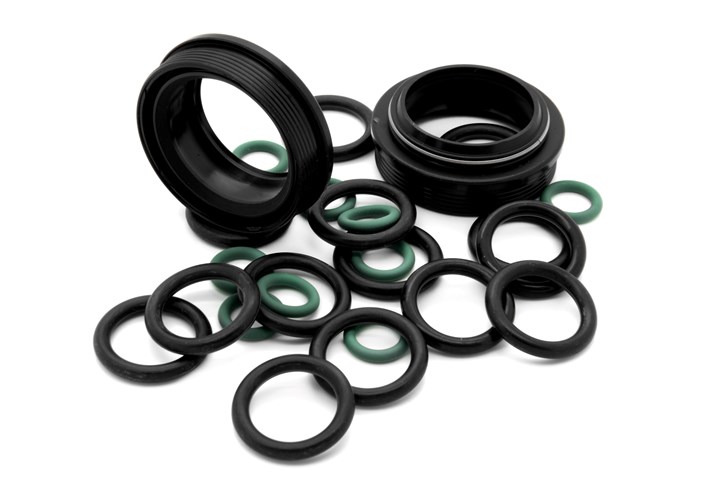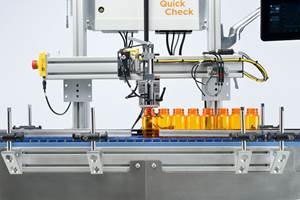Unique Coating Reduces Friction of Sliding Plastic, Ceramic and Metallic Components
Oerlikon Balzers extremely thin, hard Diamond-Like Carbon (DLC) coating decreases the COF of components to nearly zero, while increasing wear resistance
A specialty film coating described as a type of diamond-like coating (DLC) from Oerlikon Balzers has been shown to reduce the coefficient of friction (COF) of sliding plastic as well as ceramic and metallic components to nearly zero, which increasing wear resistance.

The company identifies this as a ta-C (Tetrahedral Amorphous Carbon) type of DLC coating, sold under the tradename Balinit Milubia. Such coatings are the closest in terms of mechanical properties of the diamond, and are less common tht the a-C-H coating formulations. Whils the ta-C is not a new formulation, the new innovation entails its application on plastic components and elastomers (amongst others) without any electroplated or any other metallic plating in between. This is said to allow for the excellent wear resistance and low friction of the coating at a reasonably low cost.
From an industrial perspective, the application of the ta-C coating directly on the polymer is definitely new, according to Oerlikon Balzers, which indicates that while there are many U.S. producers of DLC coatings, they are not aware of any other company providing a similar offering at this time.. With Balinit Milubia, they can coat directly on top of the polymer, circumventing the issues related to the electroplated coatings. Balinit Milubia is applied with a proprietary Filtered Cathodic Arc process which allows the coating to perform at very low temperature and on insulating substrate materials (contrary to standard PACVD technology used for DLC).
Unlike ceramics, polymers are relatively soft and quickly wear or are damaged in high contact, high friction applications. When the ta-C DLC coating is applied over a polymer substrate, it can provide a coating hardness of up to 50 GPa to increase component durability and lifespan. Polymers are traditionally difficult to coat with DLC coatings, but the ta-C coating can be applied at a temperature below 150 F/65 C) which is low enough to avoid thermal deformation of most polymers.”
Traditional coatings are also difficult to apply over an insulating substrate. With excessive friction, polymers tend to accumulate an electrostatic load that could cause severe damage if not safely discharged. As a solution, the ta-C DLC coating can attenuate or evacuate electrostatic discharge (ESD) on polymer substrates and also modifying its surface energy. The same process can be used to increase or decrease the wettability of polymers as required.
Most thermoplastics and elastomer can be coated with this technology including: PE, PEEK, PC, PPS, ABS, PTFE, PI, nylons, PET, TPU, as well as glass or carbon fiber reinforced polymers as well as woven materials. For the elastomers the company has good experience with NBR, FKM, HNBR and Silicon rubbers
Key applications include components used in water, lubricated, or submersed environments, which face considerable tribological challenges that can ultimately affect performance and reduce the life of the larger system- particularly those that come in contact or slide against other parts. This process includes pump parts, mechanical seals, and high-pressure valves manufactured often using ceramic substrates designed to survive wet, corrosive environments.
Related Content
Linear Leak Tester with Upgraded Controls and Versatility
Indexing-conveyor system tests a wider range of bottle sizes and offers expanded remote support and data reporting.
Read MoreUltrasonic Welding: Tips, Techniques, and Troubleshooting
In this collection of content, we provide expert advice on welding from some of the leading authorities in the field, with tips on such matters as controls, as well as insights on how to solve common problems in welding.
Read MoreA Guide to Ultrasonic Welding Controls
Ultrasonic welding today is a sophisticated process that offers numerous features for precise control. Choosing from among all these options can be daunting; but this guide will help you make sense of your control features so you can approach your next welding project with the confidence of getting good results.
Read MoreCan Plastic Recyclates be Welded Ultrasonically?
What is possible with ultrasound? Will the result with recycled plastics material actually be worse than with standard material? Do we have to adapt our technology?
Read MoreRead Next
Lead the Conversation, Change the Conversation
Coverage of single-use plastics can be both misleading and demoralizing. Here are 10 tips for changing the perception of the plastics industry at your company and in your community.
Read MoreRecycling Partners Collaborate to Eliminate Production Scrap Waste at NPE2024
A collaboration between show organizer PLASTICS, recycler CPR and size reduction experts WEIMA and Conair will seek to recover and recycle 100% of the parts produced at the show.
Read More









 (2).jpg;maxWidth=300;quality=90)














